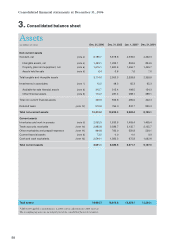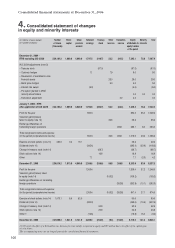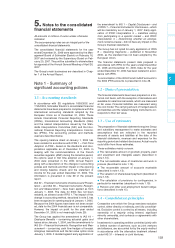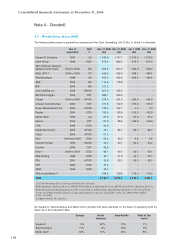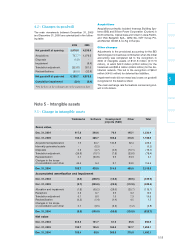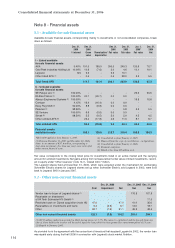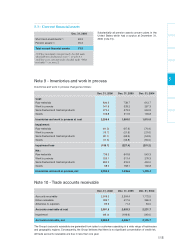APC 2006 Annual Report Download - page 107
Download and view the complete annual report
Please find page 107 of the 2006 APC annual report below. You can navigate through the pages in the report by either clicking on the pages listed below, or by using the keyword search tool below to find specific information within the annual report.
Supplementary pension benefits
The Group also provides supplementary pension ben-
efits to a limited number of active and retired senior
executives. These defined benefit obligations are
accrued for based on the contractual terms of the
agreements, which provide guaranteed minimum ben-
efits over and above those paid under general pension
schemes.
Other commitments
Provisions are booked to cover the cost of providing
healthcare benefits for certain retired employees in
Europe and the United States.
The Group also records for all its subsidiaries an obli-
gation for seniority-related benefits (primarily long
service awards in its French subsidiaries).
1.18 - Share-based payment
The Group grants different types of share-based pay-
ment to senior executives and certain employees.
These include:
Options to buy existing Schneider Electric shares
and to subscribe new shares.
Shares granted without consideration.
Stock Appreciation Rights (SARs).
IFRS 2 –
Share-based payment
– applies only to plans
set up after November 7, 2002 than did not vest prior
to January 1, 2005.
In accordance with IFRS 2, these plans are valued on
the date of grant, using the Cox, Ross, Rubinstein
binomial option pricing model, and are recognized as
an expense over the vesting period, generally three or
four years depending on the country.
A contra entry is posted to the own shares reserve for
shares granted without consideration and for options
to purchase or subscribe shares. In the case of SARs,
a liability is recorded corresponding to the amount of
the remeasured benefit at the closing date.
1.19 - Provisions for contingencies
A provision is recorded when the Group has a present
obligation as a result of a past event, and a reliable
estimate can be made of the amount of the obligation.
If the obligation is not probable and cannot be reliably
estimated, but remains possible, it is classified as a
contingent liability and disclosed in the notes to the
consolidated financial statements. Provisions are cal-
culated on a case-by-case or statistical basis. Long-
term provisions (greater than one year) are discount-
ed. Discounting adjustments for long-term provisions
were calculated at a rate of 3.8% at December 31,
2006, 3.2% at December 31, 2005, and 3.4% at
December 31, 2004.
Provisions are primarily set aside to cover:
Economic risks. These include tax risks arising from
tax audits performed by various local tax administra-
tions and financial risks arising primarily on guaran-
tees given to third parties in relation to certain assets
and liabilities.
Customer risks. These provisions primarily concern
liability claims arising from alleged defects in products
sold to customers and other third parties and are
determined on a case-by-case basis.
Technical risks:
- Provisions are recorded on a statistical basis for the
residual cost of product warranties not covered by
insurance. Such warranties may run up to 18 months.
- The Group also recognizes provisions to cover dis-
putes concerning defective products and recalls of
clearly identified products.
Environmental risks. These provisions are primarily
set aside to cover potential reclamation costs.
Restructuring costs, when the Group has prepared a
detailed formal plan for the restructuring and has either
announced or started to implement the plan at year-
end.
1.20 - Financial liabilities
Financial liabilities primarily comprise bonds and short
and long-term bank debt. These liabilities are initially
recorded at fair value, taking into account any direct
transaction costs, and subsequently measured at
amortized cost based on their effective interest rate.
1.21 - Financial instruments
and derivatives
Risk hedging management is centralized. The Group’s
policy is to use derivative financial instruments exclu-
sively to manage and hedge changes in exchange
rates, interest rates or prices of certain raw materials.
These risks are managed and hedged primarily
through the use of swaps, options and futures,
depending upon the nature of the Group’s exposure.
Derivative financial instruments are never used for
speculative purposes.
Foreign currency hedges
The Group periodically enters into foreign currency
contracts to hedge foreign currency transactions.
Some of these contracts are designated as hedges of
operating receivables and payables carried in the bal-
ance sheets of Group companies. The Group does not
apply hedge accounting to these instruments because
at year-end, foreign currency contracts are marked to
market and gains or losses are recorded in other finan-
cial income and expense. These gains or losses offset
the losses or gains arising from converting foreign cur-
rency payables and receivables into the reporting cur-
rency at year-end rates, in accordance with IAS 21 –
The effects of changes in foreign exchange rates.
The Group may also hedge recurring future transac-
tions or planned acquisitions or disposals of invest-
ments. In accordance with IAS 39, these are treated as
cash flow hedges. The hedging instruments are recog-
nized in the balance sheet and are measured at fair
value at the period-end. The portion of the gain or loss
on the hedging instrument that is determined to be an
effective hedge is accumulated in equity, under other
reserves, and recognized in the income statement when
the hedged transaction affects profit or loss. The ineffec-
tive portion of the gain or loss on the hedging instrument
is recognized in other financial income and expense.
In addition, certain long-term receivables and loans to
subsidiaries are considered to be part of the Group’s
net investment, as defined by IAS 21 –
Net Investment
in a Foreign Operation
. In accordance with the rules
governing net investment hedging, the impact of
exchange rate fluctuations is recorded in equity and
recognized in the statement of income when the
investment is sold.
105
5





